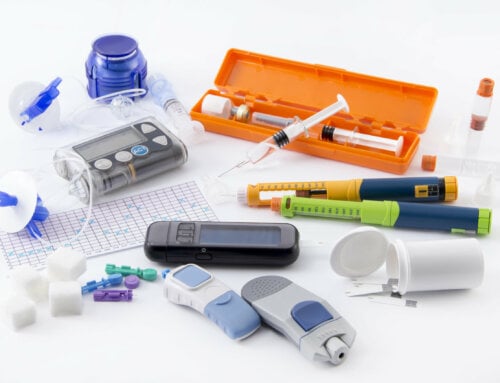Proper foot care is essential for people with diabetes. From poolside to bedside, you should keep your feet covered to avoid injuries. Discover why you need to take care of your feet everyday and keep them covered.
- Sometimes people with diabetes cannot feel pain or discomfort in their feet due to poor circulation or nerve damage known as neuropathy. Blisters, wounds, bunions, ingrown toenails, fungus, athlete’s foot, hammertoes and persistent dryness which lead to skin cracks can cause serious infections. When your blood glucose is high, infections can worsen. An infection that does not heal can lead to gangrene and even amputation. Keep your feet dry, clean and covered at all times to avoid injuries and related infections. Monitor your blood sugars regularly.
- Walking barefoot can lead to cuts, scrapes, calluses and more. Always wear shoes wherever you go. Have slippers handy when you get home and wake up. Wear water shoes to the pool, in the pool or beach to avoid injury and infection. Rocks, sand, glass and items dropped on the ground can all be dangerous to your feet. Clear pathways, watch where you are going and keep your feet covered. Socks and stockings help prevent blisters and shoes protect your feet from injuries.
- Make sure your shoes fit properly. You might want to steer clear of open shoes such as thong sandals or flip flops. Sometimes people with diabetes cannot feel a rock or sand in their shoes until it is too late. Check the inside of your shoes for objects before you put them on. Have your feet measured to determine the right shoe size. A podiatrist might recommend certain shoes for people with diabetes who experience inflammation and other problems which have a deep toe box. Wear the right shoes or sneakers for exercising to avoid blistering. Another way to keep feet comfortable is wearing absorbent diabetic socks.
- Proper foot care is essential for people with diabetes. Wash your feet in warm water everyday and dry them well especially between the toes. Check your feet daily for sores, blisters, cuts, redness and other problems. Use lotion to get rid of dry skin and do not put lotion between your toes. Consider powder with corn starch for between- toes health. Gently rub corns and calluses after your shower or bath by using a pumice stone. Cut your toenails weekly to the shape of your toe and never cut them too short. File rough edges with an emery board. Always wear shoes and socks. If you have trouble cutting your toenails, visit a podiatrist. If you get pedicures make sure they disinfect the equipment. Avoid crossing your legs, which cuts off circulation. Quit smoking as it also impairs your circulation.
- Discuss foot problems with your doctor immediately. Take off your shoes and socks before the doctor enters the room to ensure your feet are checked during exams. Once a year ask your doctor to check the blood flow and nerve sensation in your feet by using a monofilament test. Talk to your doctor about the best way to trim your toenails and which lotion is good to use on your feet and legs.
Keeping your feet covered at all times can help you avoid a variety of foot problems. Inspecting your feet daily and taking care of them properly wards off potential infections. If you can not see the bottoms of your feet have someone else check them. Your feet carry you everywhere so be good to them!






Leave A Comment